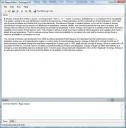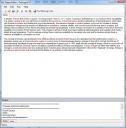Sep
6
Nerdy t-shirts
Filed Under sayansi, tarakirishi by Mucheru | Comments Off on Nerdy t-shirts
Working at a software company, I’ve gotten to see a fair share of nerdy t-shirts. There are the those celebrating various video games, software launches etc. Then there are the programming references (“Wanna grab a byte?”).
Probably nobody does programming humor better than XKCD – their “my code is compiling” and “sudo make me a sandwich” shirts are pretty common. This week, I saw two shirts that are in contention for the title of “Most Awesome T-shirt Ever”.
The first had a decidedly complicated looking equation on the front, giving the value of Vs. The caption read “Airspeed velocity of an unladen swallow“. Priceless. I was tempted to ask if the swallow was African or European.
The second had a big bold “i2” on the front with the caption “keeping It real“. That made my day!
Oct
25
Math’s use of language
Filed Under hisabati, sayansi, tarakirishi by Mucheru | Leave a Comment
Here’s a gem from the Ars mathamatica blog.I don’t think I could put it better if I tried.
You know, mathematical terminology cannot be parodied. Mathematicians have invented groups, semigroups, quasigroups, pseudogroups, and two mostly-unrelated concepts both known as groupoids. They have invented both formal groups and quantum groups, neither of which are kinds of groups. And while the study of groups is a branch of algebra, most groups are not, in fact, algebraic.
Check out the comments for the post
Jun
7
Recommending Links for articles in Wikipedia
Filed Under sayansi, teknolojia by Mucheru | Leave a Comment
In senior year of college, I took an class that blended information theory, algorithms and networking. It was called “Algorithms at the end of the wire”. My project for that class was an application that finds links for articles in Wikipedia.
Working off the ideas presented in class on search results ranking and vector space models, we proposed that given a query article (an article to add links in), we can find some k articles already in Wikipedia that are most similar to it. We can then we can use the links in those articles to infer the links to create in the query article. In particular, each of the neighboring articles could suggest links for text that they had in common with the query and the set of neighbors would vote on the link with weighing applied based on how close the particular voting article was to the query article. As the mechanism for determining the k nearest neighbors, we would fetch articles from the Wikipedia corpus that had text occurring in the query article then rank the results and pick the top k. Ranking was done separately using PageRank and using Latent Semantic Indexing then the rankings were aggregated.
You can download a prototype of an editor implementing our algorithm here . The editor depends on a web service so you need to be connected to the internet to use it. This is a C# application so you can run it in windows or in Linux using Mono.
May
15
Nadharia katika Sayansi ya Tarakirishi
Filed Under sayansi, teknolojia by Mucheru | Leave a Comment
Maswali na majibu baada ya Gödel na Turing
Neno sayansi linatokana na neno “scio” la kilatini lenye maana ya kujua ama kufahamu. Hivyo basi, masomo yote yanayochukuliwa kuwa aina ya sayansi yanajihusisha na kutafiti ukweli wa mambo – iwe ni kwa kufanya majaribio (ambapo inakuwa sayansi tendeshi) au kwa kukisia kanuni za ukweli na kuzithibitisha (ambapo inakuwa ni sayansi nadharia).
Nitakayoyazungumzia hapa ni historia fupi ya utafiti wa sayansi ya kompyta, haswa maswali yaliyoanzisha usomi huu. Kwa watu wengi, masomo ya tarakirishi huchukuliwa kuwa miongoni mwa masomo ya uhandisi. Ni kweli kwamba sehemu nyingi za somo hili zinazojihusisha na kifaa tarakirishi chenyewe – iwe ni hadweya au softweya ya vifaa – na sehemu hizi huwa ni uhandisi. Lakini pia, somo hili linajihusisha na mengi zaidi ya haya – ukiangalia asili la neno kompyuta utapata linatokana na neno “compute” la kiingereza ambalo lina maana ya “kupata jibu, hasa kwa swali la hisabati, kwa kutumia kanuni fulani”[1] . Tutakavyoona sayansi hii inahusika na maswali ya muundo wa “Je swali hili linajibika kwa kufuatia kanuni?”,”Linahitaji kanuni ngapi?” n.k. Read more

